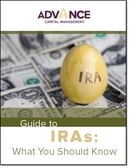Spending Down Your Savings: IRA Withdrawal Rules
December 7th, 2022 | 3 min. read

Saving for retirement can feel like a long, upward climb. Taking step after step, saving dollar after dollar. But the view at the top is worth it… except the journey isn’t over. You now have to navigate your way down. That is, you have to take money from your savings to fund your retirement without tripping up.
One of the most common places to keep retirement savings is in an individual retirement account (IRA). Like a 401k, you purchase investments (mutual funds, individual stocks, bonds, etc.) to help grow that money to eventually withdraw as income in retirement.
For all retirement accounts, the IRS has rules for how you can save money but also how you can take money out. Confusing things is that these rules can be tax benefit or a costly mistake if you take the wrong step. So, if you’re concerned about how to efficiently spend down your retirement savings, the following breakdown of IRA withdrawal rules will help get you moving.
Traditional v. Roth IRA
The two main types of IRAs are traditional IRAs and Roth IRAs.
Some people transfer their savings from a 401k or other work plan into an IRA once they retire. Others contribute to an IRA in addition to their employer’s retirement plan while working.
The major difference is in how they’re taxed. The contributions made to a traditional IRA are not taxed, making them pre-tax dollars. On the other hand, contributions to a Roth IRA are taxed, making them after-tax dollars.
As we’ll see below this distinction is important as it determines what IRA withdrawal rules apply to your account.
Traditional IRA withdrawal rules
Of course, the IRS wants you to pay your taxes.
Since you don’t pay taxes on your contributions to a traditional IRA, you must pay taxes on your withdrawals. So, when you start taking money out of a traditional IRA for retirement expenses, you will owe taxes on that amount. The tax is your ordinary income tax.
That’s not all.
If you withdraw any money from a traditional IRA before age 59 ½, you may be subject to a 10% federal penalty tax on top of ordinary income taxes. Exceptions include: a first-time home purchase, qualified higher education expenses and disability.
Traditional IRAs are also subject to annual required minimum distributions (RMDs), the amount the federal government requires you to withdraw from some retirement accounts upon turning age 72.
Roth IRA withdrawal rules
Since you pay taxes on the money you contribute to a Roth IRA, you have much more freedom with your withdrawals than a traditional IRA.
Generally, withdrawals from a Roth IRA are tax-free. You can withdraw contributions tax-free at any age. You typically pay no taxes on earnings as well.
There is one caveat for tax-free Roth IRA withdrawals known as the five-year rule. The five-year rule: Withdrawals from a Roth IRA are tax- and penalty-free as long as you have owned the account for at least five years.
As with a traditional IRA, an early withdrawal tax penalty can apply, but only to any earnings you withdraw. If you are younger than age 59 ½, income tax and a 10% federal tax penalty may be applied to the early withdrawal of earnings from a Roth IRA.
Another major advantage: Roth IRAs are not subject to RMDs.
Traditional IRA or Roth IRA?
As a quick review: traditional IRAs are taxed on the backend and Roth IRAs are taxed upfront.
Based on the IRA withdrawal rules covered above, you may be wondering: which is best for you in retirement?
A simple way to arrive at an answer is to ask yourself whether you expect your future tax rate to be higher than your current tax rate. The goal, of course, is to pay at the lower rate.
Basically, a traditional IRA may make sense if you think your tax rate will be lower in retirement. On the other hand, if you think your tax rate will be higher in retirement, then a Roth IRA is likely a better option.
For people nearing or in retirement, a strategy that can help limit the tax burden is a Roth conversion. This is the transfer of some or all your funds from a traditional IRA to a Roth IRA. It then allows you to take advantage of the tax-free withdrawals with no RMDs. Keep in mind, a Roth conversion is a taxable event, in which you pay taxes on the money you rollover that you haven’t paid taxes on before. So, there are a variety of tax rules to navigate here, which you may want to do with the guidance of a financial professional to avoid triggering any unnecessary taxes.
Ready to start navigating the path into retirement?
There are a lot of moving parts when it comes to using your savings to live the retirement you want. And rarely is the way forward clearly laid out in front of us. But you don’t have to go it alone. As you navigate the rules for withdrawing funds from your accounts, ask a financial adviser to review your current financial situation, make detailed financial projections and help determine which steps are most appropriate for you.
Learn more about saving and investing in an IRA by downloading our Guide: IRAs: What You Should Know. Whether you’re a stay-at-home parent, small business owner, freelancer or someone who just ,maxed out their 401(k), our guide explains how you can save for retirement.

Advance Capital Management is a fee-only RIA serving clients across the country. The Advance Capital Team includes financial advisers, investment managers, client service professionals and more -- all dedicated to helping people pursue their financial goals.

